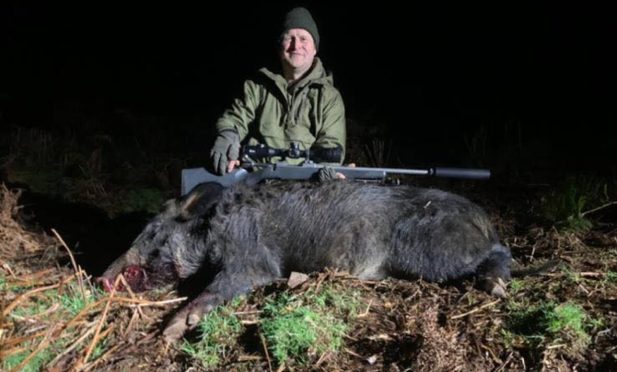Landowners and farmers in the Highlands say the wild boar population is “out of control” and fear someone will be killed or seriously injured.
Thousands of feral pigs roam freely around the Great Glen – 80 miles of lochs and rivers from Glencoe and Fort William to Inverness – but it has been claimed they are closing in on the Highland capital.
The omnivores can weigh over 200kg – 30 stone – and are considered dangerous wild animals, to be controlled by individual land managers.
Government body NatureScot says numbers are in the “low thousands”, but locals say it’s closer to the 5,000 mark due to wild boar breeding with domestic or hairy pigs.
However, landowners, farmers and gamekeepers told The Press and Journal the population is becoming “unmanageable”.
It’s claimed the animals have been spotted near Torvean, less than a mile from Inverness city centre.
Staff at Kings Golf Club say they are aware of sightings further down the Glen, with gamekeepers working to “divert the wild boar away from the club”.
Gamekeeper Robert Sanderson believes the population is now “out of control” and claims to have come across one that was 37 stone.
Mr Sanderson, of Highland Deer Management, said: “The numbers of wild boar are growing, and growing.
“We are at the point with their population that it is becoming unmanageable. They got out of the box, and they have been breeding.
“I don’t know if we can ever get them back in the box.”
“I have had reports of evidence of them at Dochfour and at least three wild boar in Torvean Quarry.
“Because they are quite secretive animals, it is really important to see the evidence.
“They are up at Contin and Alness, and they are all the way down the Dores side of Loch Ness.
“They will go everywhere and anywhere with tree coverage and fresh vegetation.”
Mr Sanderson added: “There has been some success in controlling the boar with deer fencing.
“But on the whole, the boar can destroy land very quickly.”
Wild boar are the ‘real Loch Ness monsters’
Asked if the animals are aggressive, he said: “If you are walking a dog then wild boars are not very friendly – but they will tend to run away.
“If they have piglets with them, then they are defensive and can get very aggressive.”
“Until very recently people have treated the wild boar as an urban myth. But not any longer – it is a pressing problem.”
Catherine Mclennan, 53, who farms 100 acres of land above the A82 on the banks of Loch Ness, near Drumnadrochit, described the situation as “out of control”.
She told The Press and Journal the animals cause a “devastating” amount of damage to winter grazing land, digging it up every year.
She said: “I came into contact with the wild boar one night when I went into a wooded area on my land. There were dozens of them on the land.
“I took off at the rate of knots.
“There have been people coming across the wild boar and being chased by them.”
She warned: “Someone will get killed or badly hurt.
“These wild boar are the real Loch Ness monsters, some are the size of a small car.”
Wild boar are causing havoc
She continued: “There has been a litter each year from each sow of eight or nine piglets, and then after six months, those pigs can breed.
“We are looking at a population of between 2,000 and 5,000 animals. ”
NatureScot is unaware of reports of wild boar being near Inverness.
The agency is working with partners to count the feral pigs and hopes to release more accurate population data in February 2025.
A spokesperson said: “In Scotland, there are at least four separate breeding populations of feral pigs, located in the Great Glen, Lochaber, Dumfries and Galloway and Ross-shire.
“Wild boar can interbreed with domestic pigs, and we believe many illegally released pigs in Scotland are hybrids between wild boar and domestic pigs or breeds of hairy pig.
“NatureScot and Forest and Land Scotland have developed best practice advice to guide land managers in controlling feral pig populations safely and humanely.
“A licence is not required, as feral pigs are not a protected species.”
Have you signed up for our Oban and Hebrides newsletter?
Every week our Oban-based reporter Louise Glen curates the best news in the area.
Sign up here for local news straight to your inbox.




Conversation